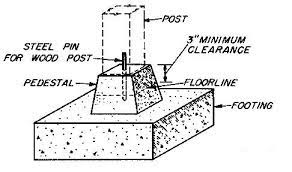In the ever-evolving landscape of construction, materials and techniques that offer versatility, strength, and adaptability take center stage. Pedestal concrete, a specialized form of construction, has emerged as a solution that not only provides structural support but also serves aesthetic and functional purposes. In this article, we delve into the characteristics, applications, and benefits of pedestal concrete, uncovering its significance in contemporary construction practices.
Defining Pedestal Concrete:
Pedestal concrete, often referred to as raised or elevated concrete, involves the creation of elevated platforms or supports using concrete. These pedestals can vary in size, shape, and purpose, serving as a foundational element for various structures, machinery, or architectural features.
Structural Integrity and Load-Bearing Capacity:
The primary role of pedestal concretes is to provide a robust and stable foundation for structures or equipment. These pedestals are engineered to withstand specific loads and environmental conditions. The careful design and placement of pedestal concretes ensure that it can effectively bear the weight and stress imposed by the supported elements.
Adjustable Systems for Uneven Surfaces:
Pedestal concrete systems often feature adjustable elements that allow for installation on uneven surfaces. This adaptability is particularly valuable in construction projects where the ground is not perfectly level. Adjustable pedestals can compensate for variations in the terrain, providing a level and stable surface.
Applications in Outdoor Spaces:
Pedestal concrete finds extensive use in outdoor spaces for creating raised platforms, decks, or patios. These elevated surfaces offer numerous benefits, including improved drainage, protection against moisture and pests, and the ability to conceal utilities beneath the surface. Pedestal concrete is a popular choice for rooftop gardens, outdoor dining areas, and raised walkways.
Supporting Architectural Elements:
In architectural design, pedestal concrete is often utilized to support various elements, such as statues, sculptures, or architectural features. The elevation provides a visual emphasis on these elements, creating a sense of prominence and importance within a space. Pedestals can be tailored to complement the overall design aesthetic of the structure.
Raised Flooring Systems:
Pedestal concretes is an integral part of raised flooring systems in both residential and commercial settings. This application is particularly prevalent in areas where underfloor access is necessary for utilities, such as wiring, plumbing, or HVAC systems. The raised flooring provides a hidden infrastructure while maintaining accessibility for maintenance and upgrades.
Environmental Considerations:
The use of pedestal concretes in outdoor applications aligns with environmental considerations. Elevated platforms allow for improved air circulation and reduced water accumulation, minimizing the risk of decay and enhancing the longevity of structures. Additionally, the space created beneath raised surfaces can be utilized for stormwater management, contributing to sustainable urban design.
Customization and Aesthetics:
Pedestal concrete systems offer a high degree of customization, allowing architects and designers to create unique and visually appealing spaces. The pedestals can be tailored to various shapes and sizes, accommodating the specific requirements of the project. This versatility facilitates the creation of aesthetically pleasing designs that seamlessly integrate with the overall architectural vision.
Accessibility in Construction:
Pedestal concrete simplifies the construction process, especially in areas with challenging access or difficult terrain. The ability to adjust the pedestals to match the topography eliminates the need for extensive site preparation, reducing the overall construction time and costs. This makes pedestal concretes an attractive choice for projects in diverse geographical locations.
Technological Advancements:
With advancements in construction technology, pedestal concretes systems have evolved to include innovative features. Some systems incorporate self-leveling capabilities, allowing for even greater precision in adjusting to uneven surfaces. These technological enhancements further enhance the efficiency and accuracy of pedestal concrete applications.
Conclusion:
Pedestal concrete stands as a testament to the innovation and adaptability within the construction industry, offering solutions that go beyond traditional foundation methods. Whether providing support for outdoor spaces, architectural elements, or raised flooring systems, pedestal concrete showcases its versatility and functionality. As architects and builders continue to explore creative and sustainable construction practices, the elevated excellence of pedestal concrete is likely to remain a fundamental component of modern construction projects.

